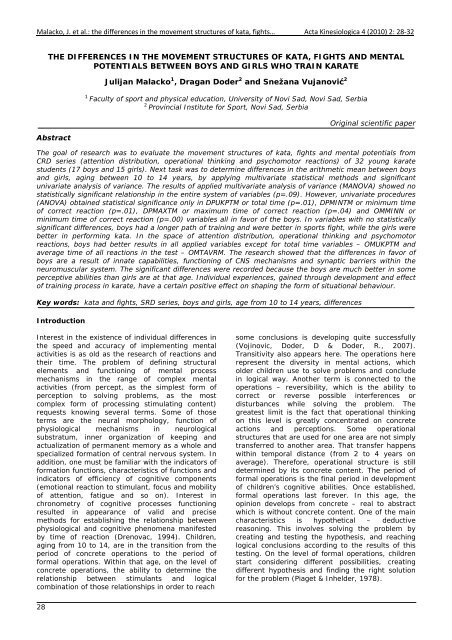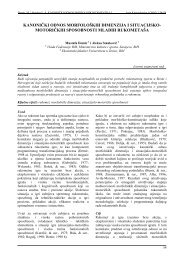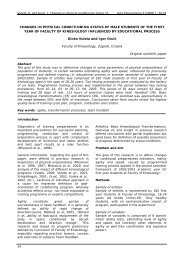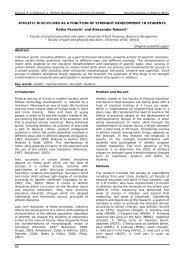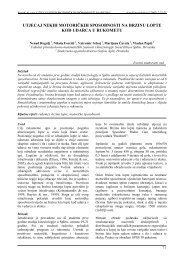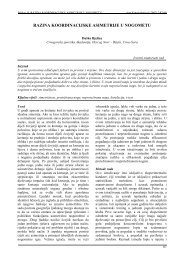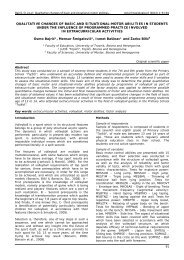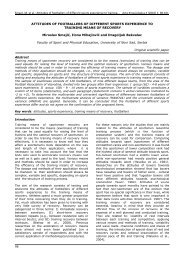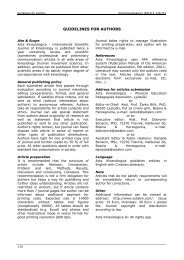04 CL 05 JM.pdf - Acta Kinesiologica
04 CL 05 JM.pdf - Acta Kinesiologica
04 CL 05 JM.pdf - Acta Kinesiologica
You also want an ePaper? Increase the reach of your titles
YUMPU automatically turns print PDFs into web optimized ePapers that Google loves.
Malacko, J. et al.: the differences in the movement structures of kata, fights… <strong>Acta</strong> <strong>Kinesiologica</strong> 4 (2010) 2: 28‐32<br />
THE DIFFERENCES IN THE MOVEMENT STRUCTURES OF KATA, FIGHTS AND MENTAL<br />
POTENTIALS BETWEEN BOYS AND GIRLS WHO TRAIN KARATE<br />
Julijan Malacko 1 , Dragan Doder 2 and Snežana Vujanović 2<br />
1<br />
Faculty of sport and physical education, University of Novi Sad, Novi Sad, Serbia<br />
2<br />
Provincial Institute for Sport, Novi Sad, Serbia<br />
Abstract<br />
Original scientific paper<br />
The goal of research was to evaluate the movement structures of kata, fights and mental potentials from<br />
CRD series (attention distribution, operational thinking and psychomotor reactions) of 32 young karate<br />
students (17 boys and 15 girls). Next task was to determine differences in the arithmetic mean between boys<br />
and girls, aging between 10 to 14 years, by applying multivariate statistical methods and significant<br />
univariate analysis of variance. The results of applied multivariate analysis of variance (MANOVA) showed no<br />
statistically significant relationship in the entire system of variables (p=.09). However, univariate procedures<br />
(ANOVA) obtained statistical significance only in DPUKPTM or total time (p=.01), DPMINTM or minimum time<br />
of correct reaction (p=.01), DPMAXTM or maximum time of correct reaction (p=.<strong>04</strong>) and OMMINN or<br />
minimum time of correct reaction (p=.00) variables all in favor of the boys. In variables with no statistically<br />
significant differences, boys had a longer path of training and were better in sports fight, while the girls were<br />
better in performing kata. In the space of attention distribution, operational thinking and psychomotor<br />
reactions, boys had better results in all applied variables except for total time variables – OMUKPTM and<br />
average time of all reactions in the test – OMTAVRM. The research showed that the differences in favor of<br />
boys are a result of innate capabilities, functioning of CNS mechanisms and synaptic barriers within the<br />
neuromuscular system. The significant differences were recorded because the boys are much better in some<br />
perceptive abilities than girls are at that age. Individual experiences, gained through development and effect<br />
of training process in karate, have a certain positive effect on shaping the form of situational behaviour.<br />
Key words: kata and fights, SRD series, boys and girls, age from 10 to 14 years, differences<br />
Introduction<br />
Interest in the existence of individual differences in<br />
the speed and accuracy of implementing mental<br />
activities is as old as the research of reactions and<br />
their time. The problem of defining structural<br />
elements and functioning of mental process<br />
mechanisms in the range of complex mental<br />
activities (from percept, as the simplest form of<br />
perception to solving problems, as the most<br />
complex form of processing stimulating content)<br />
requests knowing several terms. Some of those<br />
terms are the neural morphology, function of<br />
physiological mechanisms in neurological<br />
substratum, inner organization of keeping and<br />
actualization of permanent memory as a whole and<br />
specialized formation of central nervous system. In<br />
addition, one must be familiar with the indicators of<br />
formation functions, characteristics of functions and<br />
indicators of efficiency of cognitive components<br />
(emotional reaction to stimulant, focus and mobility<br />
of attention, fatigue and so on). Interest in<br />
chronometry of cognitive processes functioning<br />
resulted in appearance of valid and precise<br />
methods for establishing the relationship between<br />
physiological and cognitive phenomena manifested<br />
by time of reaction (Drenovac, 1994). Children,<br />
aging from 10 to 14, are in the transition from the<br />
period of concrete operations to the period of<br />
formal operations. Within that age, on the level of<br />
concrete operations, the ability to determine the<br />
relationship between stimulants and logical<br />
combination of those relationships in order to reach<br />
some conclusions is developing quite successfully<br />
(Vojinovic, Doder, D & Doder, R., 2007).<br />
Transitivity also appears here. The operations here<br />
represent the diversity in mental actions, which<br />
older children use to solve problems and conclude<br />
in logical way. Another term is connected to the<br />
operations – reversibility, which is the ability to<br />
correct or reverse possible interferences or<br />
disturbances while solving the problem. The<br />
greatest limit is the fact that operational thinking<br />
on this level is greatly concentrated on concrete<br />
actions and perceptions. Some operational<br />
structures that are used for one area are not simply<br />
transferred to another area. That transfer happens<br />
within temporal distance (from 2 to 4 years on<br />
average). Therefore, operational structure is still<br />
determined by its concrete content. The period of<br />
formal operations is the final period in development<br />
of children’s cognitive abilities. Once established,<br />
formal operations last forever. In this age, the<br />
opinion develops from concrete – real to abstract<br />
which is without concrete content. One of the main<br />
characteristics is hypothetical – deductive<br />
reasoning. This involves solving the problem by<br />
creating and testing the hypothesis, and reaching<br />
logical conclusions according to the results of this<br />
testing. On the level of formal operations, children<br />
start considering different possibilities, creating<br />
different hypothesis and finding the right solution<br />
for the problem (Piaget & Inhelder, 1978).<br />
28
Malacko, J. et al.: the differences in the movement structures of kata, fights… <strong>Acta</strong> <strong>Kinesiologica</strong> 4 (2010) 2: 28‐32<br />
Problem and aim<br />
In attempts to determine the specific personalities<br />
of a sportsman, it is accessing to research<br />
programs in order to determine which psychological<br />
abilities prevail in the population of sportsmen in<br />
general and in specific sports. The aim is to<br />
determine the significant differences in<br />
personalities between genders, which is the<br />
problem of our research. The goal of the research is<br />
to determine the differences in movement<br />
structures of kata, fights and mental potentials<br />
from CRD series (attention distribution, operational<br />
thinking and psychomotor reactions) between boys<br />
and girls training karate.<br />
Methods<br />
Sample of entities<br />
The sample included 32 young karate students (17<br />
boys and 15 girls) from Novi Sad, in the age from<br />
10 to 14 years.<br />
Sample of variables<br />
The sample of variables consisted of 15 variables,<br />
three of which were used to evaluate the<br />
movement structures of kata and fights, and 12<br />
were used for evaluating mental potential from CRD<br />
series (attention distribution, operational thinking<br />
and psychomotor reactions). For evaluating the<br />
movement structures of kata and fights, following<br />
variables were applied: 1. training length<br />
(DUZTREN), 2. evaluation of the efficiency in<br />
performing kata (OCEKATA) – speed and strength<br />
demonstration, good balance, proper breathing,<br />
timeliness, steady and calm transition with feet<br />
firmly on the ground, proper tension, precision,<br />
focus, understanding of kata, contraction, contrast<br />
in tension, breathing, movement and rhythm of<br />
kata, 3. evaluation of efficiency in fight (OCBORBE)<br />
– fighting with proper form (fighting stance,<br />
moving, manifestation of strength, proper distance)<br />
and zanshin (self-control, focus, serenity and<br />
poise). Assessment of situational moving structure<br />
was measured with the average grade from 1 to 5<br />
given by 3 examiners per each examinee (Doder,<br />
1998; Doder, 2000). For evaluating mental<br />
potential, CRD series was used. It consists of 38<br />
standard tests, which are used for testing<br />
perceptive abilities of thinking, memory and<br />
different types of psychomotor reactions<br />
(Drenovac, 1994; Zivicnjak, Zebec, Franke, Filler,<br />
Szirovica, Haffner, Querfeld, Enrich & Rudan,<br />
2001). 1. CRD 2-41 is a test of identifying<br />
progressive series of numbers – attention<br />
distribution: total time (DPUKPTM), minimum time<br />
of correct reaction (DPMINTM), maximum time of<br />
correct reaction (DPMAXTM) and average time of all<br />
reactions in the test - the total time of correct and<br />
incorrect reactions divided with the number of<br />
reactions (DPTAVRM). CRD 2-41 test was made<br />
according to the tests called “numeric box” where<br />
three-digit numbers from 101 to 140, which form<br />
an appropriate continuum, are randomly distributed<br />
in a number of squares. Examinee must find the<br />
numbers in ascending order, and mark the position<br />
of a certain number by clicking the button, placed<br />
under or above that number. When the examinee<br />
marks the correct position of a certain number, he<br />
gets a back tone, while a skipped number and all<br />
the following numbers are treated as incorrect. CRD<br />
2-41 test is used for measuring the scope, or in<br />
other words the distribution of attention. 2. CRD 4-<br />
11 is an operational thinking test: total time<br />
(OMUKPTM), minimum time of correct reaction<br />
(OMMINTM), maximum time of correct reaction<br />
(OMMAXTM) and the average time of all reaction in<br />
the test – the total time of correct and incorrect<br />
reactions divided with the number of reactions<br />
(OMTAVRM). CRD 4-11 test contains a signal circuit<br />
of four indicator lights and lit light shows which<br />
limb should react. In the tests, 1, 2 or 3 lights turn<br />
on and the examinee must respond by pressing the<br />
button with one or more limbs. The test consists of<br />
35 tasks and it examines the speed and accuracy of<br />
operational thinking while managing synchronized<br />
movement of arms and legs. 3, CRD 4-33 is simple<br />
psychomotor reaction test: total time (PRUKPTM),<br />
minimum time of correct reaction (PRMINTM),<br />
maximum time of correct reaction (PRMAXTM) and<br />
average time of all reactions in the test – total time<br />
of correct and incorrect reactions divided with the<br />
number of reactions (PRTAVRM). CRD 4-33 test<br />
contains a signal circuit with one lamp and one<br />
button for responding. The task of the examinee is<br />
to press as fast as possible the button for respond<br />
when the light signal appears, while pressing the<br />
button before the signal appears is considered as a<br />
mistake. The test contains 35 tasks and it<br />
measures the speed of simple psychomotor<br />
reaction.<br />
Data processing method<br />
For every applied variable, the following statistical,<br />
central and dispersion parameters have been<br />
calculated: M- arithmetic mean, min- minimum<br />
value, max-maximum value and standard<br />
deviation. Normal distribution of variables was<br />
tested using Sk - skewness. For determining the<br />
difference in arithmetic mean of applied variables<br />
between boys and girls, a multivariate statistical<br />
methods and univariate analysis of variance<br />
(MANOVA\ANOVA) were used. Multivariate testing<br />
of null hypothesis, where the group centroids are<br />
equal to the common centroid (GENERAL MANOVA),<br />
was carried out with λ - Wilks’ lambda test, F-test<br />
and p - statistic significance
Malacko, J. et al.: the differences in the movement structures of kata, fights… <strong>Acta</strong> <strong>Kinesiologica</strong> 4 (2010) 2: 28‐32<br />
So the gained discriminant results are satisfactory,<br />
except for PRMINTM variable or minimum time of<br />
correct reaction (Sk=-1.63), which negative<br />
measures of asymmetry indicate a number of<br />
higher values. At girls, the majority of applied<br />
variables also do not deviate from normal<br />
distribution, except in OMMAXTM or maximum time<br />
of correct reaction (Sk=1.46), PRUKPTM or total<br />
time (Sk=1.52), PRMAXTM or maximum time of<br />
correct reaction (Sk=2.56) and PRTAVRM or<br />
average time of all reactions in the test (Sk=1.17).<br />
Table 1: The basic statistical parameters and testing the normality of their distribution<br />
Varijable M SD min max Sk<br />
♂♂ ♀ ♂♂ ♀♀ ♂♂ ♀♀ ♂♂ ♀♀ ♂♂ ♀♀<br />
MOVEMENT STRUKTURES OF KATA AND FIGHTS<br />
DUŽTREN 5 4.4 1.6 2.1 2 1 7 8 -.46* -.02*<br />
OCEKATA 3.1 3.1 1.5 1.6 1 1 5 5 -.09* -.12*<br />
OCBORBE 3.6 2.6 1.5 1.72 1 1 5 5 -.59* .43*<br />
MENTAL POTENTIAL<br />
CRD 2-41 - test attention distribution<br />
DPUKPTM 38228.4 46261.3 6507.8 10<strong>04</strong>8 27514 31445 48185 67565 -.08* -.24*<br />
DPMINTM 482.1 556.7 51 111.8 406 349 573 706 .06* -.37*<br />
DPMAXTM 1956.5 2420.6 544.2 694.9 1220 1273 3015 3749 .53* .43*<br />
DPTAVRM 857.1 965.2 151.6 191.9 632.6 666.7 1175.1 1318 .95* .38*<br />
CRD 4-11 - operational thinking test<br />
OMUKPTM 3<strong>04</strong>790 292970 92671 53666 173361 207369 521228 389212 .65* .43*<br />
OMMINTM 571.9 757.1 184.8 116.9 326 514 901 914 .67* -.45*<br />
OMMAXTM 33498.1 37189.3 135<strong>05</strong> 14441 13375 17770 67869 72868 .77* 1.46<br />
OMTAVRM 7221 7133.2 1846.5 1210.1 4334 4937.3 10092 9085.4 -.<strong>04</strong>* .12*<br />
CRD 4 -33 - psychomotor reaction test<br />
PRUKPTM 1<strong>04</strong>67 10815.1 2346.3 3102.3 7663 7688 16241 19359 .90* 1.52<br />
PRMINTM 184.6 191.7 27.1 32.1 102 112 227 246 -1.63 .63*<br />
PRMAXTM 375.2 484.5 77.1 267.1 269 276 531 1334 .93* 2.56<br />
PRTAVRM 287.8 299.9 55.1 76.2 218.9 216.5 427.3 496.4 .91* 1.17<br />
M - arithmetic mean, SD - standard deviation, min - minimum value, max - maximum value,<br />
Sk - skewness, * - normal distribution, ♂- boys ♀- girls.<br />
Table two shows the gained multivariate statistic<br />
significance in arithmetic mean of boys and girls on<br />
the level .09 (p=.09), which is not statistically<br />
significant. Univariate procedures (ANOVA)<br />
obtained statistical significance only in DPUKPTM or<br />
total time (p=.01), DPMINTM or minimum time of<br />
correct reaction (p=.01), DPMAXTM or maximum<br />
time of correct reaction (p=.<strong>04</strong>) and OMMINN or<br />
minimum time of correct reaction (p=.00) variants,<br />
all in favor of the boys. In variables with no<br />
statistically significant differences, boys had a<br />
longer path of training and were better in sports<br />
fight, while the girls were better in performing kata.<br />
In the area of attention distribution, boys had<br />
better results in all applied variables (total time or<br />
DPUKPTM, minimum time of correct reaction or<br />
DPMINTM, maximum time of correct reaction or<br />
DPMAXTM and average time of all reactions in the<br />
test or OMTAVRM) because they had shorter<br />
minimum time of correct reaction. In operational<br />
thinking, boys had reactions that were more correct<br />
in minimum time of correct reaction or DPMINTM<br />
and in maximum time of correct reaction or<br />
DPMAXTM variables. The girls were better in total<br />
time or OMUKPTM and average time of all reactions<br />
in the test or OMTAVRM variables. In psychomotor<br />
test, boys had better results in all applied variables<br />
(total time or PRUKPTM, minimum time of correct<br />
reaction or PRMINTM, maximum time of correct<br />
reaction or DPMAXTM and average time of all<br />
reactions in the test or PRTAVRM).<br />
Table 2: Statistical parameters univariate and<br />
multivariate analysis of variance (ANOVA/MANOVA)<br />
Variable M♂ M♀ F p<br />
MOVEMENT STRUCTURES<br />
OF KATA AND FIGHTS<br />
DUŽTREN 5.00* 4.4 0.81 0.4<br />
OCEKATA 3.11 3.13* 0 1<br />
OCBORBE 3.58* 2.6 2.92 0.1<br />
MENTAL POTENTIAL<br />
CRD 2-41 - test attention distribution<br />
DPUKPTM 38228.35* 46261.27 7.37 .01*<br />
DPMINTM 482.<strong>05</strong>* 556.73 6.14 .01*<br />
DPMAXTM 1956.52* 2420.6 4.47 .<strong>04</strong>*<br />
DPTAVRM 857.10* 965.24 3.16 0.1<br />
CRD 4-11 - operational thinking test<br />
OMUKPTM 3<strong>04</strong>789.5 292969.70* 0.18 0.7<br />
OMMINTM 571.88* 757.13 11.1 .00*<br />
OMMAXTM 33498.06* 37189.33 0.55 0.5<br />
OMTAVRM 7221.01 7133.23* 0.02 0.9<br />
CRD 4 -33 - psychomotor reaction test<br />
PRUKPTM 1<strong>04</strong>67.00* 10815.07 0.13 0.7<br />
PRMINTM 184.64* 191.66 0.44 0.5<br />
PRMAXTM 375.17* 484.46 2.6 0.1<br />
PRTAVRM 287.84* 299.93 0.26 0.6<br />
λ = .35 F = 1.96 p = .09<br />
M♂- boys, M♀- girls<br />
ANOVA: F - test; p- statistic significance
Malacko, J. et al.: the differences in the movement structures of kata, fights… <strong>Acta</strong> <strong>Kinesiologica</strong> 4 (2010) 2: 28‐32<br />
Discussion and conclusion<br />
Boys differ from girls in reactions and individual<br />
efficiency in performing certain mental and motor<br />
activities because of genetic potentials and<br />
functioning of mechanisms in psychoneural system,<br />
and because of individual experience, gained<br />
through anthropological development and the<br />
impact of sports on shaping the situational conduct<br />
(Malacko, 2009). Sports coaches, pedagogues,<br />
psychologists and sportsmen consider the question<br />
whether there is a specific psychological structure<br />
of sportsmen personality or a special organization<br />
of personal dispositions. The most acceptable<br />
answer is given based on the results of the<br />
researches (Dempster, 1985; Dempster, 1993;<br />
Enns & Girgus 1986; Platsidou, Demetriou & Kui<br />
1997; Hale, 1990; Malacko & Doder, 2008) which<br />
show that sportsmen differ in the level of<br />
expressing individual dispositions or groups of<br />
personality dispositions. Interest in individual<br />
differences in the speed and accuracy of<br />
implementing mental activities is as old as the<br />
research of reactions and their time. This question<br />
has been seriously taken into consideration because<br />
of the increased interest for knowing the nature,<br />
structure and singularity of individual perception,<br />
so called the personal equation of the perceiver.<br />
However, which factors determine individual<br />
personalities and inter - individual differences in<br />
reactions, as well as how much those differences in<br />
individual efficiency in performing certain mental<br />
activities are a result of innate abilities and<br />
functioning of mechanisms in psycho neural system<br />
are yet to be answered. Also the questions how<br />
much are those differences determined by<br />
individual experiences gained through development<br />
and by effect of social impact on shaping the forms<br />
of situational conduct in some environmental<br />
situations still cannot be integrally answered.<br />
Considering all this questions (according to<br />
Drenovac, www.crd.hr) Lange discovered that time<br />
of simple reaction is dependent on the object where<br />
the examinee directs his attention: sensorperceptive<br />
or motor component of the task. Based<br />
on the knowledge from these researches Lange<br />
differentiated two types or forms of simple reaction<br />
– sensor type, where the attention is focused on<br />
the stimulant, and muscular type where the<br />
attention is focused on the performing the<br />
movement. Therefore, one can assume that boys<br />
are type that is more muscular and the girls are<br />
more sensor type. Austrian physiologist Eksner<br />
(www.crd.hr) (who introduced the term “time of<br />
reaction” used for marking the necessary time for<br />
conscious reply to a certain sensor stimulation)<br />
asks a very current question –time of reaction<br />
dependency on different subjective and objective<br />
factors, individual characteristics (gender, age…),<br />
characteristics of examinee, modality of the<br />
stimulation, conditions in which the experiment is<br />
taking place, etz. Eksner was the first to describe<br />
the state of examinee in his expectation and his<br />
readiness in preparatory period, between the presignal<br />
and stimulant, as well as the influence of<br />
supporting and inadequate stimulants on the time<br />
of a simple reaction. Review of available literature,<br />
about reactions and time of reactions as well as<br />
about the correlation between chronometrical<br />
indicators of efficiency in implementing cognitive<br />
functions and those significances in individual<br />
mental potentials, measured by classical paper-pen<br />
ability tests, proved that certain aspects of that<br />
problems are unequally represented. They have<br />
been studied in different degrees and they<br />
occasionally give contradictory conclusions about<br />
the factors that determine characteristics of<br />
components, structure and manifestations of<br />
different kinds of reactions (Drenovac,<br />
www.crd.hr). Based on the literature and relevant<br />
authors, our research has shown that boys and<br />
girls, aging from 10 to 14, do not significantly differ<br />
in the whole system of applied variables<br />
(multivariant). However, considering univariate<br />
analysis, boys had better results in DPUKPTM or<br />
total time (p=.01), DPMINTM or minimum time of<br />
correct reaction (p=.01), DPMAXTM or maximum<br />
time of correct reaction (p=.<strong>04</strong>) and OMMINN or<br />
minimum time of correct reaction (p=.00)<br />
variables. The research showed that the differences<br />
in favor of the boys are a result of innate<br />
capabilities, functioning of CNS mechanisms and<br />
synaptic barriers within the neuromuscular system.<br />
The significant differences were recorded because<br />
the boys are much better in some perceptive<br />
abilities than girls are at that age. Individual<br />
experiences, gained through development and<br />
effect of training process in karate, also have a<br />
certain positive effect on shaping the situational<br />
conduct.<br />
Literature<br />
Dempster, F.N. (1985). Short-term memory development in childhood and adolescence. In Brainerd CJ,<br />
Pressley M eds. Basic processes in memory development, (pp. 209-248). New York: Springer Verlag.<br />
Dempster, F.N. (1993). Resistance to interference: Developmental changes in basic processing mechanism.<br />
In Howe ML, Pasnak R eds. Emerging themes in cognitive development, (pp. 3-27). New York: Springer<br />
Verlag.<br />
Doder, D. (1998). Relacije sistema kriterijumskih specifično motoričkih varijabli, morfoloških karakteristika i<br />
motoričkih sposobnosti kod karatista dečjeg uzrasta [Relations in the system specific motor variable,<br />
morphological characteristics and motor abilities of karate students at children age. In Serbian]. /Master<br />
thesis/. Novi Sad: Faculty of physical culture.<br />
Doder, D. (2000). Efekti uticaja situacionog trenažnog programa na promene antropoloških karakteristika<br />
mladih karatista [The effects of situational training programs on the changes of anthropological<br />
characteristics of young karate students. In Serbian]. /Dissertation/. Novi Sad: Faculty of physical culture.<br />
31
Malacko, J. et al.: the differences in the movement structures of kata, fights… <strong>Acta</strong> <strong>Kinesiologica</strong> 4 (2010) 2: 28‐32<br />
Drenovac, M. (1994). CRD-Serija psihodijagnostičkih testova [CRD-series of psycho diagnose tests. In<br />
Croatian]. Zagreb: AKD.<br />
Drenovac, M. (2009). Kronometrija dinamike mentalnog procesiranja [Chronometry of mental processing<br />
dynamics. In Croatian]. Osijek: Faculty of Philosophy, University of Josip Juraj Strossmayer in Osijek.<br />
Available: http://www.crd.hr/.<br />
Eksner, S. (2009). Vrijeme reakcije i njegovo mjerenje [Time of reaction and its meassuring]. Available:<br />
http://www.crd.hr/.<br />
Enns, J.T., & Girgus, J.S. (1986). A developmental study of shape integration over space and time.<br />
Developmental Psychology 22(4), 491-499.<br />
Hale, S., (1990). A global developmental trend in cognitive processing speed. Child Developm, 61, 653-663.<br />
Malacko, J., & Doder, D. (2008). Tehnologija sportskog treninga i oporavka [Technology of sport training and<br />
recovery. In Serbian]. Novi Sad: Provincial Institute for Sports.<br />
Malacko, J. (2009). Interaction between genetic and non‐genetic potentials in the function of creation and<br />
development of sportsmen individuality. Sport Science 2(2), 36‐40.<br />
Piaget, J., & Inhelder, B. (1978). Intelektualni razvoj deteta [Intellectual development of a child. In Serbian].<br />
Belgrade: Institute for textbooks and teaching aids.<br />
Platsidou, M., Demetriou, A., & Kui Z.X. (1997). Structural and developmental dimensions of human<br />
information processing: Longitudinal and cross-cultural evidence, Psihološka obzorja, 6(1-2), 23-69.<br />
Vojinović, J., Doder., D., & Doder, R. (2007). Neurotičnost kao pokazatelj sportske uspješnosti kod djece<br />
karatista [Neurotic behavior at children karate students as a sign of success in sports], (pp. 581-586).<br />
Herald of Anthropological Society of Serbia.<br />
Živičnjak, M., Zebec, M., Franke, D., Filler, G., Szirovica, L., Haffner, D., Querfeld, U., Ehrich, J., & Rudan, P.<br />
(2001). Analysis of Cognitive and Motor Functioning during Pubertal Development: New Approach. Journal<br />
of Physiological Anthropology and Applied Human Science, 20(2), 111-118.<br />
RAZLIKE U KRETNIM STRUKTURAMA KATA, BORBI I MENTALNIM POTENCIJALIMA<br />
IZMEĐU DJEČAKA I DJEVOJČICA U KARATEU<br />
Sažetak<br />
Cilj istraživanja je bio da se na uzorku 32 mlada karatista (17 dječaka i 15 djevojčica) izvrši procjena kretnih<br />
struktura kate, borbi i mentalnog potencijala iz CRD serije (distribuciji pažnje, operativnog mišljenja i<br />
psihomotorne reakcije), a zatim primjenom statističke metode multivarijantne i univarijantne analize<br />
varijance (MANOVA/ANOVA) utvrde statistički značajne razlika između dječaka i djevojčica, uzrasta 10 do 14<br />
godina, koji se bave karateom. Rezultati analizom multivarijantne statističke značajnosti između aritmetičkih<br />
sredina dječaka i djevojčica pokazali su da ne postoji statistički značajna korelacija u cijelom sustavu<br />
primjenjenih varijabli (p=.09), dok je univarijantnim postupcima statistička značajnost dobivena samo u<br />
varijabli DPUKPTM - ukupno vrijeme (p=.01), DPMINTM - najkraće vrijeme točne reakcije (p=.01),<br />
DPMAXTM - najduže vrijeme ispravne reakcije (p=.<strong>04</strong>) i OMMINTM - najkraće vrijeme točne reakcije (p=.00)<br />
i to u korist dječaka. U varijablama kod kojih nisu postojale statistički značajne razlike dječaci su u odnosu na<br />
djevojčice imali duži staž treniranja i bili uspješniji u sportskoj borbi, dok su djevojčice bile uspješnije u<br />
izvođenju kata. U prostoru distribucije pažnje, operativnom mišljenju i psihomotornoj reakciji dječaci su,<br />
osim u varijablama ukupnog vremena - OMUKPTM i prosječnom vremenu svih reakcija u testu - OMTAVRM,<br />
imali bolje vrednosti u svim primjenjenim varijablama. Istraživanje je pokazalo da su razlike u prilog dječaka<br />
više rezultat urođenih sposobnosti i funkcioniranja mehanizama CNS i sinaptičkih barijera u okviru<br />
neuromuskulatornog sustava. Značajne razlike evidentirane su zbog činjenice da su dječaci u pogledu nekih<br />
perceptivnih sposobnosti značajno bolji od djevojčica u tom uzrastu. I individualna iskustva stečena kroz<br />
razvoj i djelovanje trenažnih procesa u karate sportu na oblikovanje formi situacijskog ponašanja ima u tom<br />
smislu određeni pozitivni utjecaj.<br />
Ključne riječi: kata i borbe, SRD serija, dječaci i djevojčice, uzrast 10-14 godina, razlike<br />
Received: July 21, 2010<br />
Accepted: December 20, 2010<br />
Correspondence to:<br />
Prof. Juijan Malacko, PhD<br />
University of Novi Sad<br />
Faculty of Sport and Physical Education<br />
21000 Novi Sad, Bul. K. Petra I 32, Serbia<br />
Tel: 00 381 (0)21 63 31 353<br />
E-mail: jmalacko@nspoint.net<br />
32


